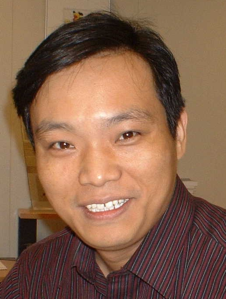Fabrication of bio-interfaces based on polymer films
Promotion Date: 15 December 2005
| A bio interface is a sensory material for bio substances. We tried to find the platform that can be used as a bio-interface, meeting several important requirements: it should have high reactivity, it should be easy to produce at a low cost. Besides there was an extra requirement: it should be highly loadable, meaning that for every molecule there should be space. In self assembly for example, the molecules pack very tightly in two dimensions leaving no space. For self assembly you also need critical conditions, a complicating factor in the production process. Polymer films are easy to prepare by chemical reaction and are cheap as well. |
What was your thesis about?
A bio interface is a sensory material for bio substances. We tried to find the platform that can be used as a bio-interface, meeting several important requirements: it should have high reactivity, it should be easy to produce at a low cost. Besides there was an extra requirement: it should be highly loadable, meaning that for every molecule there should be space.
In self assembly for example, the molecules pack very tightly in two dimensions leaving no space. For self assembly you also need critical conditions, a complicating factor in the production process. Polymer films are easy to prepare by chemical reaction and are cheap as well.
My thesis included the detailed analysis and understanding of the surface chemistry, confinement effects, and patterning on multiple length scales from the micrometer down to the sub-100 nm level, as a basis for a block copolymer-based nanometer scale screening array approach. Hence the work described in my Thesis aimed at the synthesis of suitable polymer systems, the investigation of interfacial reactions in confinement on ultrathin homopolymer and diblock copolymer polymer films, the immobilization of (bio)molecules, and the surface fabrication of biomolecular patterns by reactive microcontact printing on these reactive polymer films. Taking advantage of the micro-phase separation of diblock copolymer films, nanofabrication on ultrathin films was investigated to contribute to the future development of a model system that enables one to area-selectively deposit (write) and address (read out) biomolecules using, e.g., scanning probe lithography.
What is the result compared to self-assembled monolayers?
Comparing polymer films with self-assembled monolayers, the loading of biomolecules on polymer films is higher than that on self-assembly monolayers due to the 3 dimension behaviour of polymer films. While the functional groups on self-assembled monolayers only show 2 dimensional properties. So, the biomolecules can not only react on top of the surface, but also near top surface during reaction on polymer films.
Two polymer systems were investigated during my PhD: homo polymer and block copolymer. I started with homo polymer, showing the advantages of high reactivity and high loading, with one disadvantage however: if put in an aqueous solution the film may slowly dissolve. By introducing insoluble block into block copolymer, this disadvantage can be solved and the reactivity of the polymer films still can be kept at the same time. That is why I moved to the block copolymers.
Did you succeed?
Yes, it was very successful. We developed a new technique called reactive micro contact printing, transferring the molecules from the stamp onto the films by convalent bonding.
In doing this I developed a new aspect of the micro contact printing technique.
So your work is very close to applications?
It is. I had positive evaluation from the referee of the journal Advanced Functional Materials, saying that my method was very close to an application in industry.
What did you like most about your research?
Having succeeded in actually developing a new method. I have created something; that is the most important for me.
Was there a moment of frustration?
I had my moments of frustration when I was working on those two systems. That really caused me some worry and I had to find something, because of the time limit of only 4 years.
Did you have enough support?
Oh yes, I could discuss on a very regular basis with my daily supervisor Holger Schönherr.
Were are your from?
I am from China, the Henan Province. I went to Henan Normal University in 1992 to do chemistry and worked as a teacher in a high school after I had finished. Then I finished my Master in China and got the opportunity to a PhD in MTP group in Twente University.
And what do you think of life in the Netherlands?
It is very different indeed. When I arrived everything was new: the food, the culture, the climate, everything. But fortunately I quickly met some Chinese friends who helped me along and on the whole I have experienced nothing but kindness from the Dutch population.
For the summary of the thesis, click here.

